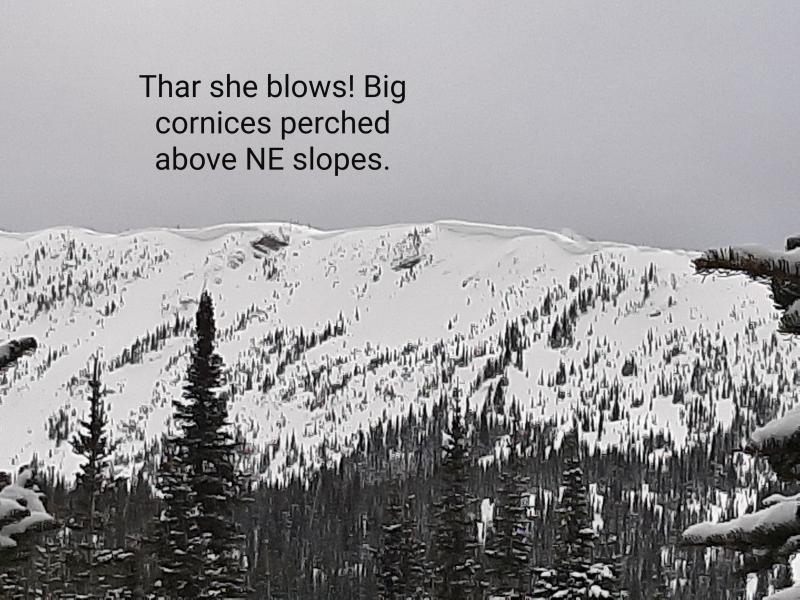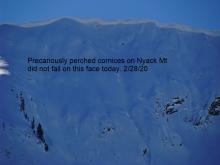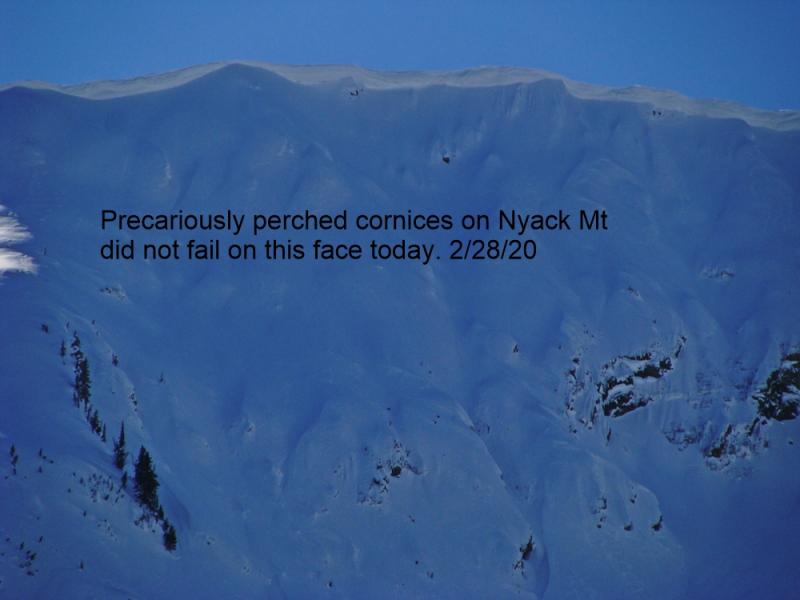| Saturday | Saturday Night | Sunday | |
|---|---|---|---|
| Cloud Cover: | Warm with early showers. | Showers. | Snow/rain with snow levels falling with cold front passage. |
| Temperatures: | 38-51 deg. F. | 31-35 deg. F. | 36-46 deg. F. |
| Wind Direction: | SW | S | SW |
| Wind Speed: | 12-15 gusts 28-39 | 9-11 gusts 23-32 | 16-18 gusts 39-44 |
| Snowfall: | 0 in. | 0 in. | 0-2 in. |
| Snow Line: |
Whitefish Range
Swan Range
Flathead Range and Glacier National Park
How to read the forecast
Wet snow avalanche problems will continue today due to warm temperatures and light rain showers in the upper elevations. It is important to pay attention to changing weather conditions. Light rain will cause the surface snow to become more unstable, particularly in unconsolidated snow that was shaded from yesterday's sun. Also watch for cornices and lingering wind slabs in steep, upper elevation terrain. The avalanche hazard is MODERATE above 5000 feet.

2. Moderate
?
Above 6500 ft.
2. Moderate
?
5000-6500 ft.
1. Low
?
3500-5000 ft.
- 1. Low
- 2. Moderate
- 3. Considerable
- 4. High
- 5. Extreme
-
Type ?
-
Aspect/Elevation ?
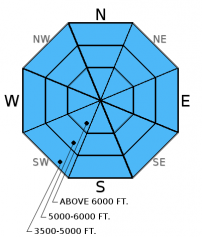
-
Likelihood ?CertainVery LikelyLikelyPossible
 Unlikely
Unlikely -
Size ?HistoricVery LargeLargeSmall

Loose, wet avalanches are possible with another warm day expected and a bit of rain to weaken the snow surface. Rollerballs, pinwheels, and a wet snow surface are signs that it is time to move to lower angle slopes. Even though wet, loose avalanches are a manageable problem they can entrain a lot of snow and have severe consequences. They pile up quickly in narrow gullies and can run you through the trees.
-
Type ?
-
Aspect/Elevation ?

-
Likelihood ?CertainVery LikelyLikelyPossible
 Unlikely
Unlikely -
Size ?HistoricVery LargeLargeSmall

Recent strong winds have added size and weight to existing cornices. Today's warming could cause cornices to become unstable. As we approach spring and daily maximum temperatures rise above freezing, cornices will likely become more sensitive. Cornice failure can also be triggered by the weight of a skier or rider, and Tuesday we found cornices that failed easily from the weight of a skier (observation). Cornices can also trigger slab avalanches on the slopes below making the consequences more severe. Give these large masses of overhanging snow a wide berth while traveling along ridges and limit your exposure time when traveling below them.
-
Type ?
-
Aspect/Elevation ?
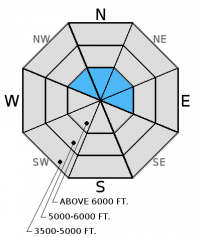
-
Likelihood ?CertainVery LikelyLikelyPossible
 Unlikely
Unlikely -
Size ?HistoricVery LargeLargeSmall

Strong to extreme winds combined with up to a foot of new snow over the past week formed wind slabs. These slabs have likely strengthened over the past few days, but human triggering is still possible at upper elevations. In some areas slabs may have formed on a preserved layer of surface hoar making them more sensitive.
Additional Concerns: A layer of buried surface hoar exists 6-14 inches below the surface in some areas. Currently, this layer is fracturing, but not propagating in stability tests. This could change with recent warming temperatures. It is important to dig into the snow, see where the layer is, and test the reactivity of this layer with stability tests. There is a reason surface hoar accounts for most uninentional human triggered avalanches by professionals. It can be tricky and spotty in distribution.
Friday: Skiers on Essex and Snowshed Mountains in the Flathead Range reported two weak interfaces in the upper-snowpack. They observed evidence of recent wind loading, and noted a thin crust forming on north facing slopes in the afternoon (observation). Skiers in the Apgar Range in Glacier National Park found a thin (9 inches), firm slab that fractured and propagated with hard force in extended column tests (observation).
Thursday: Skier in the Marion Lake area of the Flathead Range reported a couple of recent and somewhat reactive graupel layers within the top foot of the snowpack (observation).
Wednesday: In Cascade Creek in the Flathead Range, we found stubborn wind slabs on wind loaded slopes, but still did not trust wind loaded terrain. We also found buried surface hoar 6-14 inches from the surface in more shaded areas sheltered from the wind (observation) that fractured but did not propagate in extended column tests. Lower elevation snowpack is dwindling rather quickly and has become more spring-like.
Tuesday: We traveled to Sub-Shields in southern Glacier Park and found evidence of recently formed wind features and cornices at mid and upper-elevations. The cornices were soft and broke easily with the weight of a skier. There was a supportable crust to 6300 feet with a thin layer of new snow on top of this. We also found a decomposing layer of surface hoar 10 inches below the snow surface (observation).
Visit our Observations page and our You Tube channel for more observations from the entire season.
Thanks to everyone for submitting observations. They are extremely useful and could help save lives.
HOW TO SUBMIT OBSERVATIONS:
Email: [email protected]
Call and leave a message: 406.387.3821
You can also submit quick observations via text: 406.241.4571 (FAC mobile)
OR
Submit Snowpack Observations: http://www.flatheadavalanche.org/node/add/snowobs
Submit Avalanche Observations: http://www.flatheadavalanche.org/node/add/avyobs
The area got another taste of spring yesterday with sunny skies and warm temperatures. Most locations cooled to atleast near freezing overnight. Winds were out of the west-southwest at 10-20 mph with gusts from 20-34 mph. Currently, mountain temperatures range from 30º-38º F, and winds are from the south and west at 9-12 mph with gusts from 19-25 mph. Today, expect light showers with high snow levels through the early afternoon. Temperatures should rise to the upper-30s to low-40s and winds will blow out of the southwest at 5-15 mph with gusts in the 40s.
Note: The Big Mountain Summit precipitation gauge (measuring liquid water content) is currently down. We hope to have it back up in the near future.
| 0600 temperature: | 30-38 deg. F. |
| Max. temperature in the last 24 hours: | 37-42 deg. F. |
| Average wind direction during the last 24 hours: | WSW |
| Average wind speed during the last 24 hours: | 8-20 mph |
| Maximum wind gust in the last 24 hours: | 20-34 mph |
| New snowfall in the last 24 hours: | 0 inches |
| Total snow depth: | 77-101 inches |
This advisory applies only to backcountry areas outside established ski area boundaries. This advisory describes general avalanche conditions and local variations always occur. This advisory expires at midnight on the posted day unless otherwise noted. The information in this advisory is provided by the USDA Forest Service who is solely responsible for its content.













